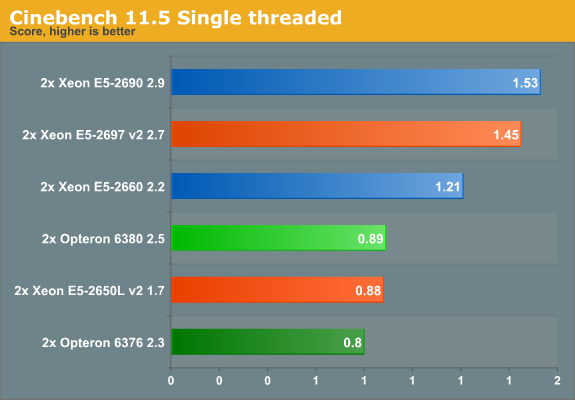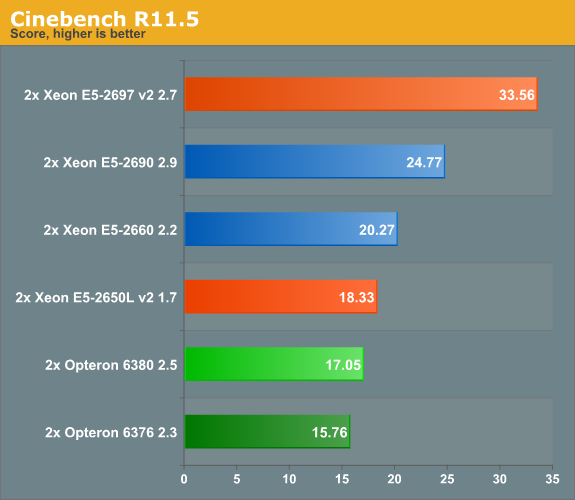Intel's Xeon E5-2600 V2: 12-core Ivy Bridge EP for Servers
by Johan De Gelas on September 17, 2013 12:00 AM ESTRendering Performance: Cinebench
Cinebench, based on MAXON's CINEMA 4D software, is probably one of the most popular benchmarks around as it is pretty easy to perform this benchmark on your own home machine. The benchmark supports up to 64 threads, more than enough for our 24- and 32-thread test servers. First we test single-threaded performance, to evaluate the performance of each core.

Cinebench achieves an IPC between 1.4 and 1.8 and is mostly dominated by SSE2 code. There is little improvement in that area, and the older 2.9-3.8GHz E5-2690 has the clock speed advantage over the new 2.7-3.5GHz E5-2697 v2. Also of note is that i n this type of code, one Piledriver core again needs 50% higher clock speed to keep up with the Ivy Bridge core.

Once we run up to 48 threads, the new Xeon can outperform its predecessor by a wide margin of ~35%. It is interesting to compare this with the Core i7-4960x results , which is the same die as the "budget" Xeon E5s (15MB L3 cache dies). The six-core chip at 3.6GHz scores 12.08. It is clear that chosing cores over clock speed is a good strategy in rendering farms: the dual E5-2650L offers 50% better performance in a power budget that is more or less the same (2x70W vs 130W).










70 Comments
View All Comments
psyq321 - Tuesday, September 17, 2013 - link
Yep, EP-46xx v2 will use the same C1 stepping (for HCC SKUs) for production parts as 2P Xeons, but there will be some features enabled in microcode which did not make it in the 26xx SKUs.EX is already on D1 stepping for QS, as the validation cycle for EX is more strict due to more RAS features etc.
Casper42 - Tuesday, September 17, 2013 - link
So I work for HP and your comments about 4x1P instead of 2x2P make me wonder if you have been sneaking around our ProLiant development lab in Houston.I was there 6 weeks ago and a decent sized cluster of 1P nodes was being assembled on an as yet unannounced HP platform. I was told the early/beta customer it was for had done some testing and found for their particular HPC app, they were in fact getting measurably better overall performance.
The interesting thing about this design was they put 2 x 1P nodes on a single PCB (Motherboard) in order to more easily adapt the 1P nodes to a system largely designed with 2P space requirements in mind.
Pretty sure the chips were Haswell based as well but can't recall for sure.
André - Tuesday, September 17, 2013 - link
Would be nice to see benchmarks for OS X, considering this thing is going inside the new Mac Pro.Final Cut X, After Effects, Premiere Pro, Photoshop, Lightroom, DaVinci Resolve etc.
I believe the 2660v2 hits the sweet spot with it's 10 cores.
DanNeely - Tuesday, September 17, 2013 - link
That'd require Apple giving Anandtech a new Mac Pro to run benchmarks on...Kevin G - Tuesday, September 17, 2013 - link
Now that Intel has officially launched the new Xeons, the new Mac Pro can't be far behind.wallysb01 - Tuesday, September 17, 2013 - link
Well, you could run the CPU benchmarks just fine. But not the GPU ones.Simon G - Tuesday, September 17, 2013 - link
Typo in Conclusion section . . . " Thta's no small feat, . . ."garadante - Tuesday, September 17, 2013 - link
There's a minor error on the Cinebench single-threaded graph. It has the clock speed for the E5-2697 v2 as 2.9 instead of 2.7, as it should be. Which is semi confusing on that graph as it explains the lower single-threaded performance from the E5-2690.SanX - Tuesday, September 17, 2013 - link
This forum has most obsolete comments design of pre-Neanderthals times, no Edit, no Delete, no look at previous user comments. Effin shameMrSpadge - Tuesday, September 17, 2013 - link
You mixed up forum and article comments.